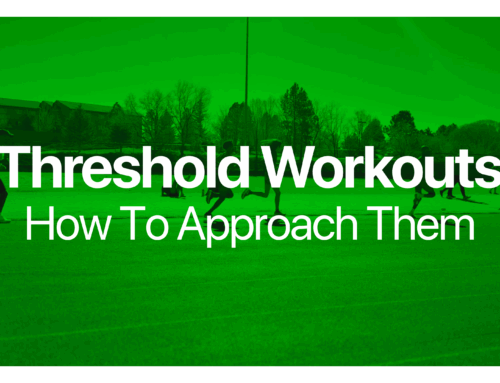Interval pace built into the VDOT Calculator and V.O2 apps is designed to stress and improve your VO2max. The key is understanding how this helps your body get faster, what it feels like and how to effectively incorporate into your training plan.
Effort
Interval training is demanding and can also be referred to as “hard” running. Imagine the speed you would average in a 10-12 minute race. The key is to spend time working at 98-100% of HRmax. Running a little less than 100% can still produce substantial benefits, hence the “I Zone” created in Daniels’ Running Formula. Suppose a maximum HR is associated with a pace of 6:00 per mile. What HR would be associated with a pace of 5:50 per mile? Your HR max. It’s quite common to run faster than necessary if you’re looking at HRmax as an indicator of working at max.
The problem with working harder than the slowest pace that elicits VO2max is that aerobically you can’t work any harder, which means you’re doing extra work at the expense of anaerobic metabolism, then lactate accumulation begins to limit you as the workout progresses. Working harder than the necessary intensity overstresses the body and provides less benefits if intervals become slower than necessary to elicit VO2max.
Benefits
Interval training improves your aerobic power, which refers to how much blood your body can deliver to the running muscles and how much of that delivered oxygen can convert fuel into energy.
Training Suggestions
Establish your Interval pace by calculating your current VDOT, then navigate to the Training tab on the VDOT Calculator. The intensity of Interval training should only change when a race performance dictates or after 4-6 weeks of consistent training. If you do increase the speed without a race result or time trial, ideally you should not exceed a one unit VDOT.
Intervals can last for 1-5 minutes but the ideal duration is between three and five minutes. Keep in mind that it can take up to two minutes to reach your VO2max starting out (assuming you’re executing pace well) so longer Intervals allow you to spend more time at max sooner. It’s also important not to run faster on shorter Intervals, which may seem easier at first, as the purpose of these sessions is stress VO2max, not improve speed (Repetition pace).
The amount of recovery you should take between repeated runs in an Interval session should be equal to, or a little less than time spent performing the preceding workbout. We recommend light jogging or walking as movement helps aid the recovery process.
Interval to Rest Ratios
- 1 minute Intervals : 1 minute recovery (E.g. 12 x 1 min at I pace)
- 2 minute Intervals : 1 minute recovery (E.g. 6 x 2 min at I pace)
- 3 minute Intervals : 2 minute recovery (E.g. 5 x 3 min at I pace)
- 4 minute Intervals : 3 minute recovery (E.g. 4 x 4 min at I pace)
- 5 minute Intervals : 4 minute recovery (E.g. 4 x 5 min at I pace)
Lastly, the amount of quality running in an Interval session should total up to 8% of your weekly mileage. For instance, if you’re running 30mpw, 5 x 800m at I pace would be acceptable. Even if you’re a high mileage runner we recommend sticking to this cap, because VO2max Intervals are without a doubt the most demanding training you can do. This is another reason you shouldn’t exceed your pace as you don’t want to compromise an upcoming quality session.
For more information, refer to Daniels’ Running Formula or email us at info@vdoto2.com.





Are this type of training included in the Adaptive Training in V.02 app?
Hi, yes, we have a variety of Interval workouts on the Adaptive Trainer. How many and what type all depends on the athlete’s preferences, mileage and VDOT score. If you have any other questions please feel free to email us at info@vdoto2.com.